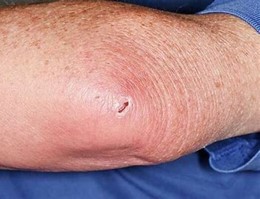Septic bursitis, cellulitis and ascending lymphangitis
A bursa is a synovial layered potential space over large joints that allows frictionless motion of structures such as tendons, over the joint as the limb changes shape with motion. Being a potential space, they can fill up with blood in the event of trauma, or an excess of synovial fluid if inflamed, typically through overuse or rheumatological condition. Typically problematic bursas in sport are the olecranon bursa at the elbow and the pre-patellar bursa at the knee.
Once a bursa is enlarged it may take a few days to settle. Once it is infected (by an overlying wound) it can take up to two weeks to improve and become less red hot and painful. Occasionally intravenous antibiotics are required to resolve septic bursitis. Although it is tempting to aspirate such areas, certainly in terms of septic bursitis there is a risk of chronic discharging sinus formation and generally this is advised against except in expert hands. An active skin surveillance program and wet healing of abrasions can reduce the risk of an elbow or knee abrasion turning into a septic bursitis.
Similarly, soft tissue infection may spread without involvement of the bursa causing temperatures and painful erythema as cellulitis. If the infection begins to spread through the lymphatic system, then visible red tracks may be seen moving up the limb with tender lymph nodes palpable in the armpits or groins.
All of the above conditions should be regarded as significant and be reviewed by a doctor for decisions about oral or intravenous antibiotics.

A red, hot and swollen elbow (olecranon) bursa with overlying wound.